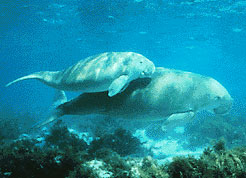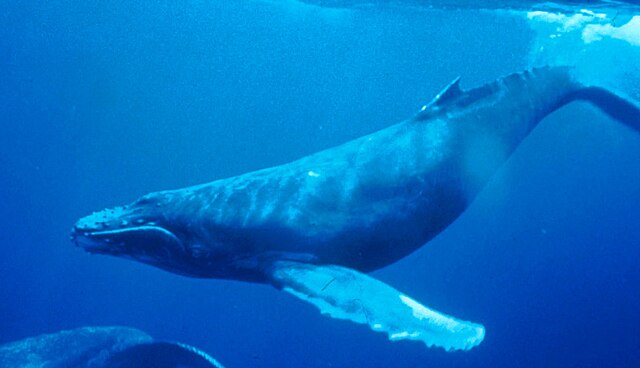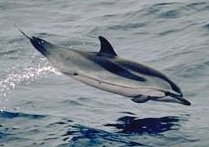List of mammals of Vanuatu
From Wikipedia, the free encyclopedia
This is a list of the mammal species recorded in Vanuatu. There are 22 mammal species in Vanuatu, of which one is endangered and four are vulnerable.[1]
The following tags are used to highlight each species' conservation status as assessed by the International Union for Conservation of Nature:
| EX | Extinct | No reasonable doubt that the last individual has died. |
| EW | Extinct in the wild | Known only to survive in captivity or as a naturalized populations well outside its previous range. |
| CR | Critically endangered | The species is in imminent risk of extinction in the wild. |
| EN | Endangered | The species is facing an extremely high risk of extinction in the wild. |
| VU | Vulnerable | The species is facing a high risk of extinction in the wild. |
| NT | Near threatened | The species does not meet any of the criteria that would categorise it as risking extinction but it is likely to do so in the future. |
| LC | Least concern | There are no current identifiable risks to the species. |
| DD | Data deficient | There is inadequate information to make an assessment of the risks to this species. |
Some species were assessed using an earlier set of criteria. Species assessed using this system have the following instead of near threatened and least concern categories:
| LR/cd | Lower risk/conservation dependent | Species which were the focus of conservation programmes and may have moved into a higher risk category if that programme was discontinued. |
| LR/nt | Lower risk/near threatened | Species which are close to being classified as vulnerable but are not the subject of conservation programmes. |
| LR/lc | Lower risk/least concern | Species for which there are no identifiable risks. |
Order: Sirenia (manatees and dugongs)

Sirenia is an order of fully aquatic, herbivorous mammals that inhabit rivers, estuaries, coastal marine waters, swamps, and marine wetlands. All four species are endangered.
- Family: Dugongidae
Order: Chiroptera (bats)
The bats' most distinguishing feature is that their forelimbs are developed as wings, making them the only mammals capable of flight. Bat species account for about 20% of all mammals.
- Family: Pteropodidae (flying foxes, Old World fruit bats)
- Subfamily: Pteropodinae
- Genus: Pteropus
- Vanuatu flying fox, Pteropus anetianus LR/lc
- Banks flying fox, Pteropus fundatus VU
- Insular flying-fox, Pteropus tonganus LR/lc
- Genus: Pteropus
- Subfamily: Macroglossinae
- Genus: Notopteris
- Long-tailed fruit bat, Notopteris macdonaldi VU
- Genus: Notopteris
- Subfamily: Pteropodinae
- Family: Vespertilionidae
- Subfamily: Myotinae
- Genus: Myotis
- Large-footed bat, Myotis adversus LR/lc
- Genus: Myotis
- Subfamily: Miniopterinae
- Genus: Miniopterus
- Little long-fingered bat, Miniopterus australis LR/lc
- Great bent-winged bat, Miniopterus tristis LR/lc
- Genus: Miniopterus
- Subfamily: Myotinae
- Family: Molossidae
- Genus: Chaerephon
- Chaerephon bregullae LR/nt
- Northern freetail bat, Chaerephon jobensis LR/lc
- Genus: Chaerephon
- Family: Emballonuridae
- Genus: Emballonura
- Polynesian sheath-tailed bat, Emballonura semicaudata EN
- Genus: Emballonura
- Family: Rhinolophidae
- Subfamily: Hipposiderinae
- Genus: Aselliscus
- Temminck's trident bat, Aselliscus tricuspidatus LR/lc
- Genus: Hipposideros
- Fawn roundleaf bat, Hipposideros cervinus LR/lc
- Genus: Aselliscus
- Subfamily: Hipposiderinae
- Family: Pteropodidae (flying foxes, Old World fruit bats)
Order: Cetacea (whales)


The order Cetacea includes whales, dolphins and porpoises. They are the mammals most fully adapted to aquatic life with a spindle-shaped nearly hairless body, protected by a thick layer of blubber, and forelimbs and tail modified to provide propulsion underwater.
- Suborder: Mysticeti
- Family: Balaenopteridae
- Subfamily: Megapterinae
- Genus: Megaptera
- Humpback whale, Megaptera novaeangliae VU
- Genus: Megaptera
- Subfamily: Megapterinae
- Family: Balaenopteridae
- Suborder: Odontoceti
- Superfamily: Platanistoidea
- Family: Ziphidae
- Subfamily: Hyperoodontinae
- Genus: Mesoplodon
- Blainville's beaked whale, Mesoplodon densirostris DD
- Ginkgo-toothed beaked whale, Mesoplodon ginkgodens DD
- Hector's beaked whale, Mesoplodon hectori DD
- Genus: Mesoplodon
- Subfamily: Hyperoodontinae
- Family: Delphinidae (marine dolphins)
- Genus: Stenella
- Pantropical spotted dolphin, Stenella attenuata LR/cd
- Striped dolphin, Stenella coeruleoalba LR/cd
- Spinner dolphin, Stenella longirostris LR/cd
- Genus: Lagenodelphis
- Fraser's dolphin, Lagenodelphis hosei DD
- Genus: Stenella
- Family: Ziphidae
- Superfamily: Platanistoidea
See also
Notes
References
Wikiwand - on
Seamless Wikipedia browsing. On steroids.